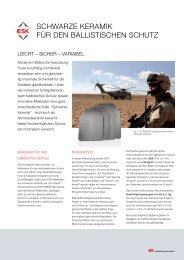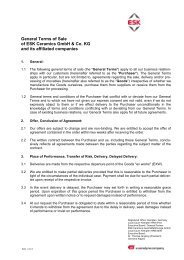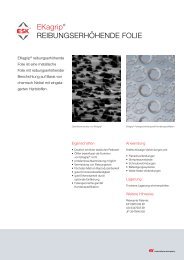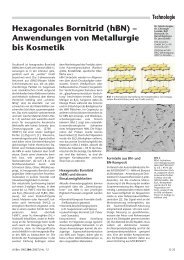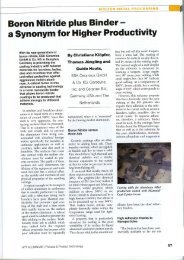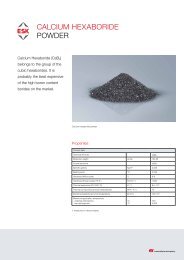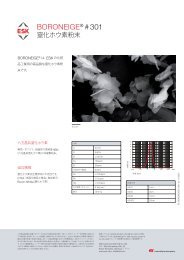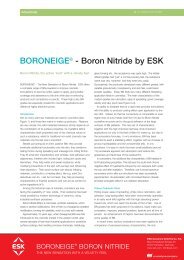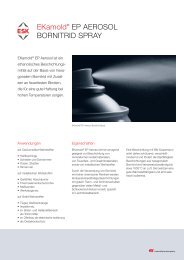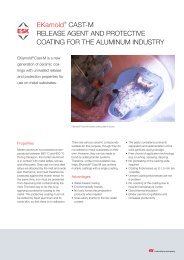Boron nitride plus binder â a synonym for higher productivity
Boron nitride plus binder â a synonym for higher productivity
Boron nitride plus binder â a synonym for higher productivity
Create successful ePaper yourself
Turn your PDF publications into a flip-book with our unique Google optimized e-Paper software.
SPECIAL<br />
ALUMINIUM SMELTING INDUSTRY<br />
Why <strong>Boron</strong> <strong>nitride</strong> has similar properties to graphite<br />
<strong>Boron</strong> <strong>nitride</strong>, a synthetic substance with the<br />
chemical <strong>for</strong>mula BN, is a sort of “inorganic<br />
carbon”. That means BN’s chemical and<br />
physical properties are very similar to those<br />
of graphite, since both compounds crystallize<br />
with the same layer lattice and almost<br />
identical dimensions. Two adjacent carbon<br />
atoms of the graphite lattice can there<strong>for</strong>e<br />
be substituted with a nitrogen and a boron<br />
atom, since two carbon atoms together<br />
have exactly the same number of electrons<br />
as a boron-nitrogen pair. Accordingly, graphite<br />
and BN are isosteric, which, as with other<br />
“isosteric pairs”, such as nitrogen and carbon<br />
monoxide or nitrous oxide and carbon<br />
dioxide, is manifested as a striking physical<br />
and chemically resistant materials <strong>for</strong><br />
manufacturing industry, emphasizes<br />
the high abrasion resistance of the<br />
new BN coatings. Heuts is responsible<br />
<strong>for</strong> the aluminium industry division<br />
in his company and understands<br />
the particular challenges faced by this<br />
sector. “Traditional coatings were always<br />
entrained by the flowing molten<br />
aluminium. But the new product adheres<br />
much better and does not have<br />
to be reapplied as often,” he explains.<br />
The coatings have much longer lifetimes<br />
if the liquid aluminium does not<br />
have a chance to attack the substrate.<br />
This could greatly reduce downtimes.<br />
The bottom line <strong>for</strong> aluminium processors<br />
is significant boost in efficiency<br />
as a result of time savings and <strong>higher</strong><br />
<strong>productivity</strong>. The improvement is<br />
documented by the results of the quality<br />
control. “With the BN coatings we<br />
tested, in contrast to traditional materials<br />
such as bone ash, the castings<br />
did not contain any residues,” Heuts<br />
assures.<br />
… and they are flexible<br />
Besides their high mechanical stability,<br />
the new BN coatings are also characterized<br />
by high flexibility. To reconcile<br />
apparently contradictory material<br />
properties, a third component<br />
was incorporated into BN coatings<br />
besides the <strong>binder</strong>. This innovation,<br />
which has also been patented, is an<br />
additive that imparts hitherto unach-<br />
and chemical similarity. For example, at temperatures<br />
of around 1600°C and pressures<br />
of 50,000 bar, graphite-like α-BN can, in a<br />
similar way to carbon, be trans<strong>for</strong>med into 2<br />
diamond-like cubic high-pressure allotropes<br />
with similar hardness to diamond. However,<br />
the striking difference between graphite and<br />
BN is that the latter is white and does not<br />
conduct electricity. That is because BN, unlike<br />
graphite, does not possess any mobile πelectrons,<br />
since, because the member atoms<br />
of the lattice are dissimilar, the “excess” electrons<br />
remain fixed to the nitrogen as “lone”<br />
electron pairs. However, more important <strong>for</strong><br />
the application in the aluminium industry is<br />
the resistance against oxidation up to 900°C<br />
ievable elasticity to the coatings. “The<br />
coatings have a levelling effect since,<br />
within certain limits, they adapt to<br />
their environment and can expand<br />
and shrink without suffering damage,”<br />
explains Christiane Klöpfer.<br />
The flexibility also applies to the<br />
adhesion of the <strong>binder</strong> to the substrate<br />
to be coated, which may be smooth or<br />
porous. “We were even able to make<br />
boron <strong>nitride</strong> adhere to graphite,”<br />
Klöpfer says. This additional property<br />
is important <strong>for</strong> graphite parts that<br />
are used in aluminium cast houses<br />
and foundries. They include rotors<br />
<strong>for</strong> melt degassing or boron <strong>nitride</strong>coated<br />
graphite thermocouple tubes.<br />
Other additives are under development.<br />
“<strong>Boron</strong> <strong>nitride</strong> has high thermal<br />
conductivity. That is counterproduc-<br />
compared to graphite which will start to oxidize<br />
already at 500°C. In its most widespread<br />
<strong>for</strong>m, as a graphite-like hexagonal boron<br />
<strong>nitride</strong>, the snow-white material possesses<br />
exceptional thermal and chemical resistance.<br />
At the same time, the highly thermally<br />
conductive material but electrically insulating<br />
boron <strong>nitride</strong> also has good lubricity. This<br />
unique combination opens up a wide field<br />
of applications in which the material often<br />
provides the critical enhancement to highend<br />
products. Some would not be possible<br />
at all without boron <strong>nitride</strong>. In this manner,<br />
the range of applications extends from electrical<br />
insulation in high-temperature furnaces<br />
to applications in the cosmetics industry.<br />
tive <strong>for</strong> aluminium production,” continues<br />
Klöpfer. For example, liquid<br />
aluminium cools by about 1°C per<br />
second on average when conveyed<br />
with ladles. This heat loss has to be<br />
compensated by auxiliary heating.<br />
ESK is currently working on BN coatings<br />
precisely tailored to the needs<br />
of the aluminium-processing industry.<br />
The aim of this work is to find a<br />
further additive that will allow us to<br />
market a boron <strong>nitride</strong> with reduced<br />
thermal conductivity.<br />
Authors<br />
Christiane Klöpfer, ESK Ceramics GmbH<br />
& Co. KG, Germany.<br />
Dr. Thomas Jüngling, Ceradyne, Inc., USA.<br />
Guido Heuts, Ceranex B.V., Netherlands.<br />
55 ALUMINIUM · 1-2/2007<br />
ALUMINIUM · 1-2/2007 55



